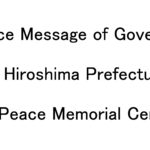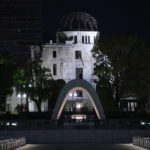Message of Governor of Hiroshima Prefecture :Here’s what Oppenheimer means to me
On July 21, the movie “Oppenheimer” was released in the United States.
The film depicts the life of the American scientist who led the development of the atomic bomb during World War II.
On the occasion of the film’s release, a message from Governor Hidehiko Yuzaki was published in the San Francisco Chronicle, calling for the realization of a world without nuclear weapons.
A Future Free of Nuclear Weapons is Possible, If We Demand It
In just a few days, moviegoers around the world will flock to the theaters to see Oppenheimer, the highly anticipated blockbuster story of the scientist at the heart of the project to build the atomic weapons the United States used against our country in 1945.
As they take in the compelling story of the man behind the bomb, we hope they also will consider how nuclear weapons have held our planet and its people hostage for more than three-quarters of a century and how the risks they pose today may be greater than ever before.
People from Hiroshima and Nagasaki need no reminder of the devasting power of nuclear weapons. Generations later, we still feel the impact of atomic bombs dropped on our cities. We also are acutely aware that while Oppenheimer is history, nuclear weapons are not.
Today, nine countries have nuclear weapons. Although the number of weapons is down significantly since the Cold War era, there are still 13,000 nuclear weapons on Earth, with approximately 90% held by Russia and the United States—more than enough destructive power to decimate human life many times over.
Even “small-scale” use of nuclear weapons would have devastating environmental impacts on our planet. One recent study assessed the global effects of a “limited” nuclear war between India and Pakistan. The fires resulting from the blasts would produce so much ash that the sun’s light could be diminished for years, leading to a “nuclear winter” that could cause a famine capable of impacting more than 3 billion people around the world.
Russia has the largest nuclear arsenal and the recent military insurrection along with ongoing political instability in the country raise the chilling prospect that the government could lose control of part of its arsenal. Government control is hardly reassuring, though, at a time when Russia has made unprecedented and dangerous nuclear threats in its war in Ukraine.
At the same time, a never-ending three-way nuclear arms race is heating up amid rising tensions with China.
In today’s world, deterrence is no longer a reliable strategy for preventing nuclear use. We are also seeing hard-fought arms-control treaties discarded, and the development of digitized nuclear weapons systems that are newly vulnerable to cyberattacks and terrorism.
No one should have to fear that an unstable leader or a terrible miscalculation could change our lives forever–as it did for our loved ones in 1945. But as long as nuclear weapons exist, humanity’s future is at risk.
It doesn’t have to be this way.
We know this because of all the progress activists have secured in reducing the world’s nuclear arsenal inventory and in maintaining a global norm against their use.
In May, our country’s Prime Minister Kishida joined President Biden and other G7 leaders in Hiroshima to reaffirm a commitment to a world without nuclear weapons. Commitments are progress, but we need to show our leaders that we all want to see words matched with action.
This year, as we prepare to mark the August 6 and 9 anniversaries of the atomic bombings of Hiroshima and Nagasaki, the world is at a crossroads. Down one path, war in Ukraine teeters on the nuclear brink, and we sit on the precipice of a new nuclear arms race that would divert resources from healthcare, education and the urgent fight against climate change. Down the other path is a safer, freer future where people and the planet are thriving, and nuclear weapons have no purpose.
We all have a role to play in leading the world down the better path.
Sadako Sasaki was a girl who inspired her classmates and then the world with the symbol of the paper crane, exemplifying that big change starts with small steps. Every August, people fold and share paper cranes around our solemn anniversaries to demonstrate support for a world without nuclear weapons. We invite you to take this first step. Just as we each transform a piece of paper into something beautiful with our own hands, we can craft a path toward a more hopeful, peaceful future—without nuclear weapons—for our loved ones and for future generations.
Robert Oppenheimer launched the atomic age, but it is up to us to end it. The future of humanity depends on it.
Hidehiko Yuzaki,the Governor of the Hiroshima Prefecture
Tags associated with this article






